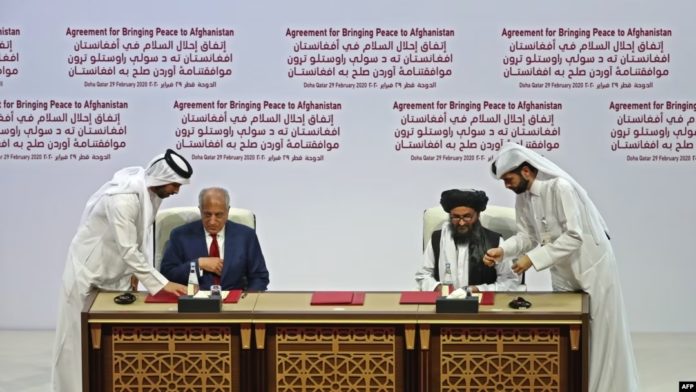Four years after the Doha Agreement, Afghanistan faces continued turmoil and uncertainty, with conflicting interests and unmet promises hindering its path to peace.
As the fourth anniversary of the Doha Agreement between the United States and the Taliban passes, Afghanistan remains mired in a complex and challenging landscape. Signed on February 29, 2020, in Doha, Qatar, the agreement was intended to chart a path towards peace and stability in Afghanistan. However, four years on, the reality on the ground tells a different story, with Afghanistan grappling with ongoing conflict, humanitarian crises, and political uncertainties.
The Doha Agreement[1], which set out a framework for the withdrawal of US forces from Afghanistan and the initiation of intra-Afghan negotiations, was hailed as a landmark development at the time of its signing. Yet, its legacy has become increasingly contentious, with allegations of violations and unfulfilled commitments casting a shadow over its supposed achievements.
One of the most glaring issues stemming from the Agreement is the persistent conflict between the Taliban and the former Afghan government. Despite the agreement’s provisions for intra-Afghan negotiations, progress towards a comprehensive peace settlement has been slow and fraught with challenges. “The lack of a responsible government in Kabul and the continued violence on the ground have hindered efforts to forge a lasting peace.
Moreover, the humanitarian situation in Afghanistan has deteriorated significantly in the wake of the agreement. “The negotiations leading to the (Doha) Agreement were deeply flawed in terms of human rights,” notes Heather Barr, head of the Human Rights and Women’s Rights section at Human Rights Watch. “Afghan women were entirely excluded from the process and discussions.”
Karine Jean-Pierre, the White House spokesperson, remarks that the Taliban had failed to uphold their pledge for “meaningful dialogue with other Afghan citizens to ensure stability and foster an all-inclusive system.” She further acknowledges that the agreement empowered the Taliban while undermining America’s allies within the former Afghan government. Jean-Pierre conceded that the complete withdrawal of U.S. forces from Afghanistan had been executed without a clearly outlined vision or strategy for the future.
Ferdaws Kawish, an Afghan journalist, says the Doha Agreement allowed the United States to disengage from a prolonged and unsuccessful conflict in Afghanistan, aligning with its desire to end involvement and reduce spending. He noted that as early as 2018, the US had made the decision to withdraw from the Afghan war, and the Doha Agreement facilitated this objective. Additionally, Kawish emphasized that combating terrorism, particularly threats posed by ISIS and Al-Qaeda, was another significant benefit for the US in Afghanistan. He pointed out that according to the terms of the Doha Agreement, the Taliban committed to counteracting ISIS and preventing Al-Qaeda from using Afghan territory against the US. Therefore, Kawish argued that the Doha Agreement served the US interests during that period by addressing these concerns.[2]
On the other hand, Acting Minister of Foreign Affairs of the Islamic Emirate, Amir Khan Muttaqi, highlights the violations committed by the United States in the aftermath of the Doha Agreement. “We noted the violation of the United States and its bombing for 14 months, during this time they committed 1,700 violations. You estimate how much blood was spilt in 1700 violations and how many were martyred.”
Muttaqi also addresses the issue of intra-Afghan talks saying, “The lack of a responsible government caused these talks to remain unsuccessful,” he remarks. “We wanted the negotiations to come to an end, the negotiations continued for a year, but no progress was seen”.[3]
While accusing the United States of violating the Doha Agreement, the Taliban harboured Ayman al-Zawahiri, the former leader of Al-Qaeda, in Kabul until he was killed in a U.S. drone strike.
Meanwhile, Anas Haqqani, a senior member of the Islamic Emirate, writes on his X page that the signing of the Doha Agreement was actually a “recognition of the freedom, independence, and dignity of Afghans.”
Haqqani also emphasizes that the international community can still fulfil its commitments and reach a common understanding with the Islamic Emirate through realistic political means.
“Four years on, it’s logical to conclude that the Doha deal was an instrument for a peaceful transition in Afghanistan, which it achieved. Addressing the issues of internal stability in Afghanistan such as a legal framework for inclusive governance, human rights and preventing Afghan soil from being used for militancy remain important challenges for the Afghan state and its people”, says Mansoor Khan, Pakistan’s former envoy to Afghanistan.[4]
Despite experiencing a level of stability unprecedented in the last fifty years, Afghanistan still faces obstacles to fully reintegrating with the global community. The international community maintains economic isolation and banking restrictions on Afghanistan, despite its improved stability. With a population of 40 million, the country resorts to dollar smuggling and informal money transfer systems like Hawala/Hundi. The Afghan Taliban’s ongoing hard-line stance on inclusivity, human rights, and counter-terrorism further complicates efforts for reconciliation.
Looking ahead, the international community must remain steadfast in its support for Afghanistan’s peace and reconstruction efforts. This includes providing humanitarian assistance to those in need, lifting economic sanctions, supporting inclusive political processes, and holding all parties accountable for their actions.
As Afghanistan navigates the complexities of its post-Doha Agreement landscape, the voices and aspirations of the Afghan people must remain at the forefront of any peace-building efforts. Only through genuine dialogue, cooperation, and a commitment to justice and reconciliation can Afghanistan hope to overcome its current challenges and build a brighter future for all its citizens.
[1] The Doha Agreement is structured around four primary provisions: Firstly, the Taliban commit to refraining from utilizing Afghan territory to threaten the security of the United States and its allies. Secondly, it outlines a timeline for the full withdrawal of US and NATO forces within 14 months. Thirdly, it mandates the initiation of intra-Afghan negotiations. Lastly, the agreement calls for discussions on achieving a comprehensive ceasefire during these negotiations.
[2] https://8am.media/eng/four-years-after-the-doha-agreement-people-of-afghanistan-still-paying-the-price/
[3] https://www.avapress.com/en/note/286245/the-doha-conference-failed-without-the-participation-of-afghan-government




